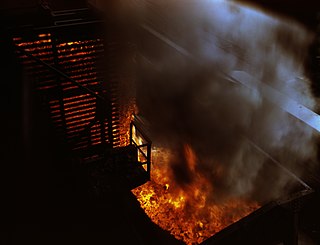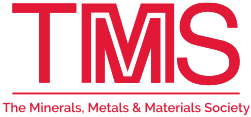The following outline is provided as an overview of and topical guide to chemistry:

Metallurgy is a domain of materials science and engineering that studies the physical and chemical behavior of metallic elements, their inter-metallic compounds, and their mixtures, which are known as alloys. Metallurgy encompasses both the science and the technology of metals; that is, the way in which science is applied to the production of metals, and the engineering of metal components used in products for both consumers and manufacturers. Metallurgy is distinct from the craft of metalworking. Metalworking relies on metallurgy in a similar manner to how medicine relies on medical science for technical advancement. A specialist practitioner of metallurgy is known as a metallurgist.
Physical Review Letters (PRL), established in 1958, is a peer-reviewed, scientific journal that is published 52 times per year by the American Physical Society. As also confirmed by various measurement standards, which include the Journal Citation Reports impact factor and the journal h-index proposed by Google Scholar, many physicists and other scientists consider Physical Review Letters to be one of the most prestigious journals in the field of physics.

In materials science, quenching is the rapid cooling of a workpiece in water, oil, polymer, air, or other fluids to obtain certain material properties. A type of heat treating, quenching prevents undesired low-temperature processes, such as phase transformations, from occurring. It does this by reducing the window of time during which these undesired reactions are both thermodynamically favorable, and kinetically accessible; for instance, quenching can reduce the crystal grain size of both metallic and plastic materials, increasing their hardness.

The Institute of Materials, Minerals and Mining (IOM3) is a UK engineering institution whose activities encompass the whole materials cycle, from exploration and extraction, through characterisation, processing, forming, finishing and application, to product recycling and land reuse. It exists to promote and develop all aspects of materials science and engineering, geology, mining and associated technologies, mineral and petroleum engineering and extraction metallurgy, as a leading authority in the worldwide materials and mining community.

The Minerals, Metals & Materials Society (TMS) is a professional organization for materials scientists and engineers that encompasses the entire range of materials and engineering, from minerals processing and primary metals production to basic research and the advanced applications of materials.
CSA was a division of Cambridge Information Group and provider of online databases, based in Bethesda, Maryland, before merging with ProQuest of Ann Arbor, Michigan, in 2007. CSA hosted databases of abstracts and developed taxonomic indexing of scholarly articles. These databases were hosted on the CSA Illumina platform and were available alongside add-on products like CSA Illustrata. The company produced numerous bibliographic databases in different fields of the arts and humanities, natural and social sciences, and technology. Thus, coverage included materials science, environmental sciences and pollution management, biological sciences, aquatic sciences and fisheries, biotechnology, engineering, computer science, sociology, linguistics, and other areas.
Robert Wolfgang Cahn FRS was a British metallurgist whose contributions to physical metallurgy centred on the properties of dislocations. Cahn developed a successful model for the nucleation of recrystallisation, which underpinned research into industrial processes involving high-temperature deformation. He also contributed substantially to the crystallography of uranium. In later life he made a great contribution to scientific editing, editing both scientific textbooks such as the comprehensive Physical Metallurgy, co-edited, with Peter Haasen, a standard reference work in the field.
Acta Crystallographica is a series of peer-reviewed scientific journals, with articles centred on crystallography, published by the International Union of Crystallography (IUCr). Originally established in 1948 as a single journal called Acta Crystallographica, there are now six independent Acta Crystallographica titles:

Tanjore Ramachandra Anantharaman was one of India's pre-eminent metallurgists and materials scientists.

steeluniversity is a collection of free and non-free e-learning resources and interactive simulations covering major aspects of ironmaking and steelmaking. It provides the underlying scientific, metallurgical, and engineering principles and environmental aspects of the production, use, and recycling of steel. These internet-delivered resources are aimed at undergraduate students of metallurgy, materials science and engineering subjects as well as graduate employees in the steel industry supply chain.
Physical metallurgy is one of the two main branches of the scientific approach to metallurgy, which considers in a systematic way the physical properties of metals and alloys. It is basically the fundamentals and applications of the theory of phase transformations in metal and alloys, as the title of classic, challenging monograph on the subject with this title. While chemical metallurgy involves the domain of reduction/oxidation of metals, physical metallurgy deals mainly with mechanical and magnetic/electric/thermal properties of metals – treated by the discipline of solid state physics. Calphad methodology, able to produce Phase diagrams which is the basis for evaluating or estimating physical properties of metals, relies on Computational thermodynamics i.e. on Chemical thermodynamics and could be considered a common and useful field for both the two sub-disciplines.

Acta Materialia is a peer-reviewed scientific journal published twenty times per year on behalf of Acta Materialia Inc. The current publisher is Elsevier. The coordinating editor is Christopher A. Schuh, Danae and Vasilis Salapatas Professor of Metallurgy at the Massachusetts Institute of Technology. The journal covers research on all aspects of the structure and properties of materials and publishes original papers and commissioned reviews called Overviews.
VINITI Database RAS is a database provided by the All-Russian Institute for Scientific and Technical Information (VINITI). The database is devoted to scientific publications. It is described as a large abstracting database. In general, it is indexed for the natural sciences, exact sciences, and technical sciences. Included in this database is AJ, indexed from 1981 to the present day.

Scripta Materialia is a peer-reviewed scientific journal. It is the "letters" section of Acta Materialia and covers novel properties, or substantially improved properties of materials. Specific materials discussed are metals, ceramics and semiconductors at all length scales, and published research endeavors explore the functional or mechanical behavior of these materials. Articles tend to focus on the materials science and engineering aspects of discovery, characterization, development, structure, chemistry, theory, experiment, modeling, simulation, physics processes, synthesis, processing (production), mechanisms, and control.
Palle Rama Rao FREng is an Indian scientist noted for his contribution to the field of Physical and Mechanical Metallurgy. He has collaborated and conducted research activities for over dozen universities and associations all over India and abroad. He has been honoured with the titles of Padma Vibhushan in 2011 by president of India for his contributions to scientific community. He is acting as the chairman, Governing Council, International Advanced Research Centre for Powder Metallurgy & New Materials (ARCI), Hyderabad.

Non-ferrous extractive metallurgy is one of the two branches of extractive metallurgy which pertains to the processes of reducing valuable, non-iron metals from ores or raw material. Metals like zinc, copper, lead, aluminium as well as rare and noble metals are of particular interest in this field, while the more common metal, iron, is considered a major impurity. Like ferrous extraction, non-ferrous extraction primarily focuses on the economic optimization of extraction processes in separating qualitatively and quantitatively marketable metals from its impurities (gangue).
Khalil Ahmad Qureshi, is a Pakistani physical chemist and the professor of physical chemistry at the Punjab University. He has published notable papers in nuclear physical chemistry in international scientific journals as well contributing in the advancement of the scientific applications of the civilian usage of the fuel cycle.
Bhakta B. Rath is an Indian American material physicist and Head of the Materials Science and Component Technology of the United States Naval Research Laboratory (NRL), the corporate research laboratory for the United States Navy and the United States Marine Corps. He is the chief administrative officer for program planning, interdisciplinary coordination, supervision and control of research and is the associate director of research for Materials Science and Component Technology at NRL.
The Journal of Alloys and Compounds is a peer-reviewed scientific journal covering experimental and theoretical approaches to materials problems that involve compounds and alloys. It is published by Elsevier and the editor-in-chief is Hongge Pan, Livio Battezzati. It was the first journal established to focus specifically on a group of inorganic elements.








